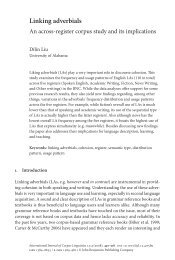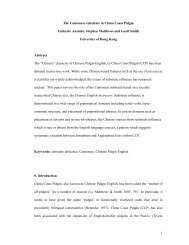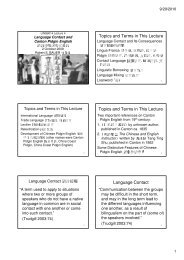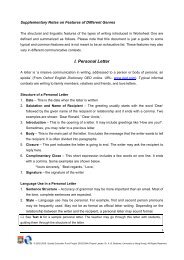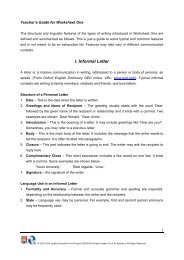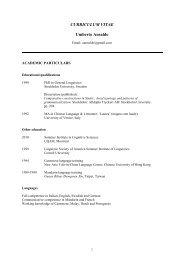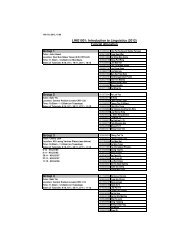The Bilingual Brain: Bilingual Aphasia
The Bilingual Brain: Bilingual Aphasia
The Bilingual Brain: Bilingual Aphasia
You also want an ePaper? Increase the reach of your titles
YUMPU automatically turns print PDFs into web optimized ePapers that Google loves.
208 FRANCO FABBRO<br />
easily avoid structures requiring obligatory pronouns while in Friulian they cannot<br />
(Fabbro & Frau 2001).<br />
<strong>The</strong> analysis of morphosyntactic errors made by the first four patients with nonfluent<br />
aphasia confirms the hypothesis that the so-called agrammatism is—as suggested<br />
by Miceli and Mazzucchi (1990)—a theoretical construct and not a natural category.<br />
In both languages these patients made omissions of free-standing grammatical morphemes<br />
and substitutions of bound grammatical morphemes (errors that are reported<br />
to be typical of agrammatism), but also a small percentage of errors came from substitutions<br />
and additions of free grammatical morphemes, which are considered specific<br />
to paragrammatism.<br />
Rehabilitation of <strong>Bilingual</strong> Aphasics<br />
A consistent rehabilitation program for aphasic monolinguals and bilinguals requires<br />
a systematic assessment of language disorders. As far as rehabilitation programs<br />
for multilingual aphasics are concerned, several questions have been raised,<br />
many of which still need a satisfactory answer, namely (1) Is it enough to rehabilitate<br />
one language in bilingual aphasics or do all languages known by the patient have to<br />
be treated? (2) If the decision is taken to rehabilitate one language only, what are<br />
the criteria behind this choice? (3) Does rehabilitation in one language also have<br />
beneficial effects on the untreated languages? (4) Do potentially beneficial effects<br />
transfer to structurally similar languages (Italian and Spanish) only or also to structurally<br />
distant languages (Italian and Japanese)? (Paradis, 1993b).<br />
Unfortunately, research on language rehabilitation in bilingual aphasics is still at<br />
an early stage (cf. Fabbro, 1999b). So far researchers have mainly analyzed individual<br />
cases and, generally, they have not carried out a proper pre- and postrehabilitation<br />
assessment of language disorders. Indeed, very few research studies assessed the<br />
patients’ linguistic abilities before and after rehabilitation with a test equivalent in<br />
both languages. Conclusions drawn from these research studies are thus still speculative,<br />
and further studies are needed if more detailed information is to be acquired.<br />
At present, only one language is generally rehabilitated, especially if the patient<br />
shows mixing or switching phenomena, so as not to confuse the patient and waste<br />
time. Should two languages be simultaneously rehabilitated, sessions would increase<br />
from three to six per week; similarly six languages would require nine sessions, and<br />
so on. With regard to the selection criteria, no clear-cut answers are provided: Some<br />
researchers claim that the mother tongue is preferable, others claim that it is the least<br />
impaired language which should be treated, others, still, claim that the language that<br />
is worst impaired should be targeted.<br />
In the case of the bilingual aphasic patients I observed, selection of the language<br />
to be rehabilitated was based on two parameters: (a) a systematic assessment of the<br />
patient’s linguistic disorders through the BAT in the languages the patient knew and<br />
(b) an interview with the patient and his/her relatives was carried out during which<br />
neurolinguistic data were collected (neurological data, results of the BAT in the languages<br />
known by the patients, etc.) and sociolinguistic issues concerning the patient<br />
and his or her family were discussed (which language they preferred to rehabilitate<br />
both for affective and for business reasons).<br />
<strong>The</strong>refore, except for highly complex neurolinguistic situations (for instance, aphasia<br />
with paradoxical recovery of one language), the choice of the language to rehabilitate<br />
depends on the patient and his or her family’s decision, since it was proven that<br />
generally the benefits of rehabilitation in one language tend to extend to the untreated<br />
languages (Fredman, 1975; Junqué, Vendrell, Vendrell-Brucet, & Tobeña, 1989).<br />
This ‘‘mass effect’’ does not seem to be due to the degree of structural similarity



